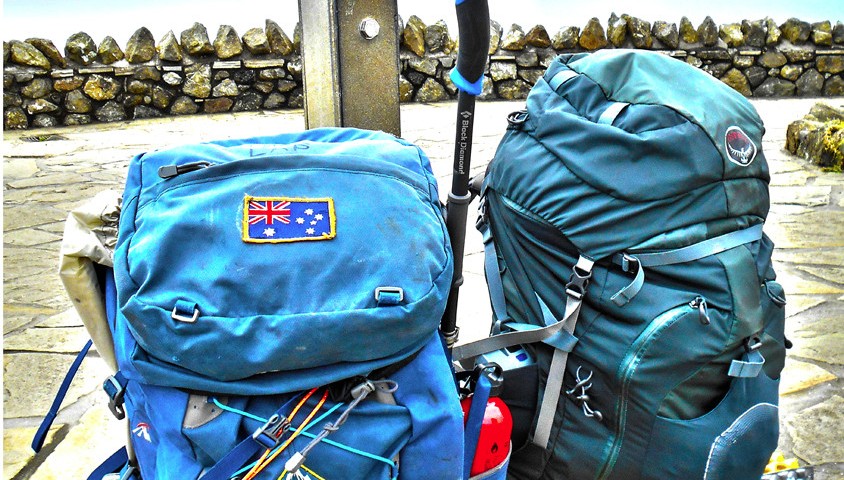Somewhere in the fecund, humid tangle of the Herekino Forest, the first of many root-crossed tramping tracks on New Zealand’s Te Araroa Trail, a fellow thru-hiker was charging through the undergrowth at a pace which far outstripped the modest efforts of our intrepid twosome. Stepping aside to allow him to overtake, I was prepared to proclaim my admiration at his clearly superior fitness before noticing that his diminutive pack was smaller than some I’ve seen hoisted by primary school students.
Until this point, I’d never seen the tenets of ultralight hiking applied in practical terms; my background and experience having been largely based on expedition mountaineering. I first came into contact with the idea via internet forums and immediately dismissed it as an eccentric fringe of the already somewhat peripheral pastime of hiking. It couldn’t be denied, however, that heavier packs were the root cause of our dearth of speed in comparison to our fleet-footed acquaintance. The concept was further impressed upon me when we were given a lift by Peter, an Australian ex-pat who provided us with coffee, home-made biscuits and a ninety minute diatribe on the apparent folly of carrying too much gear.
These events spurred me to give the concept of ultralight hiking more consideration than I’d previously afforded it. While I’d agree that there are obvious benefits to be had from minimising the carriage of weight and thus the associated negative impacts on the body, I can’t help but notice inherent problems with the enterprise.
At this stage, it may be helpful to define what the term “ultralight” actually entails. Wikipedia defines ultralight backpacking as ‘a style of backpacking that emphasizes carrying the lightest and simplest kit safely possible for a given trip’ and goes on to say that a total pack weight of under 10 pounds (4.5 kilos) is considered to fall into the ultralight category. This description therefore places a definitive, though arbitrary figure on the total weight deemed necessary for an endeavour with a description as vague as ‘a given trip’.
Essentially, the goal of the ultralight hiker is to carry as close to nothing as possible, a goal which comes very close to reality in certain circumstances. The internet abounds with ways and means to achieve this aim. Among the simpler methods are to purchase specialised lightweight gear such as tents and packs, which are engineered with a less-is-more philosophy. During our lovely morning tea, Peter disseminated further pearls of wisdom from the ultralight ethos, many of which my trekking companion described as “somewhat asinine”. These included removing labels from clothes, cutting toothbrushes in half and eschewing the carriage of water, first aid supplies and the means to cook food – you know, the basic necessities of life and other mere trifles.
Regardless of the fact that I rather value the lower half of my toothbrush, the constant pursuit of weight reduction comes at the cost of lowered safety margins, and this gives me pause. To my mind, the principals of ultralight hiking appear to be at odds with the ethics of Leave No Trace, which form the backbone of modern expeditions. Primarily, they seem to breach the first rule, which encourages adventurers to Plan Ahead and Prepare.
While I’ve no doubt that a great deal of thought and foresight has gone into the contents of an ultralighter’s backpack, the emphasis is placed largely on considerations of weight rather than preparation for contingencies of an urgent and possibly dire nature. Safety, a criteria implied by Wikipedia’s description of the endeavour, is a subjective, variable condition which is subject to a raft of external stimuli. The minimalist approach leaves little margin for error in circumstances of unpredicted weather, injury or encounters with unfriendly wildlife. It could be argued that these risk factors have been taken into consideration and weighed against the benefits of skill and experience such hikers possess, but I fear that this may not always be the case.
As outdoorspeople, we once prided ourselves on possessing the virtue of self-sufficiency. The significant movement towards ultralight practices would seem to indicate the development and acceptance of a mindset that believes that external help is no further than a Personal Locator Beacon away.
In practice, I feel that ultralight hiking may prove to be something of a double-edged sword. It’s certainly possible to pack too much, but I believe in the need to strike a balance on the bell curve of diminishing returns.
At what point does a reduction in weight cease to be of benefit and instead becomes an exercise in futility? For example, does the weight saved by carrying only muesli bars represent an overall saving in energy expenditure when compared to the carriage of a light stove and nutritionally superior food? My guess is that it doesn’t, but that’s one for the boffins and mathematicians to work out.
Personally, I feel that the extra weight I bear in the form of “luxury items” contribute greatly to my overall enjoyment of a trip and, ultimately, to its chance of success. I think it’s important to remember that adventure is an extremely subjective term. The terms by which you venture into the wilderness are factors of a greatly personal nature and your trip should reflect your wants and needs in the best possible way.
How you do that is entirely your call.



